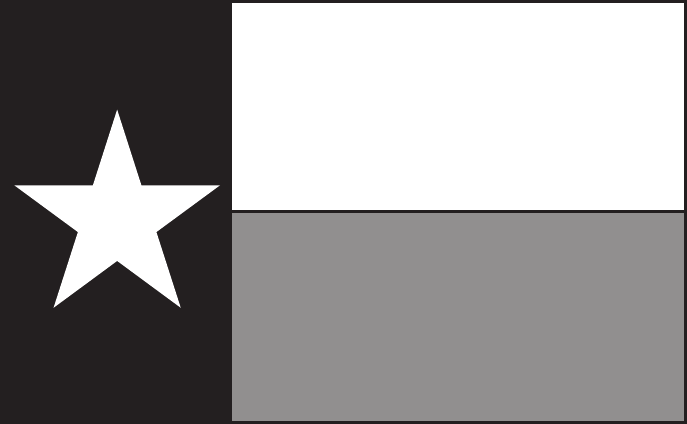
®
STAAR
State of Texas
Assessments of
Academic Readiness
GRADE 5
Science
Administered May 2021
RELEASED
Copyright © 2021, Texas Education Agency. All rights reserved. Reproduction of all or portions of this work is prohibited without express
written permission from the Texas Education Agency.
SCIENCE
Science
Page 3

DIRECTIONS
Read each question carefully. Determine the best answer to the question from
thefouranswerchoices provided.Thenfill in theansweronyouranswer
document.
1 A student recorded the time it took for all the water in a puddle on a sidewalk to
evaporate after a rain. Which kind of energy causes water to evaporate?
A
Light energy
from streetlights
B Sound energy from passing cars
C Thermal energy from the environment
D Mechanical energy from nearby streets
2 Earth
continuously rotates on its axis while also moving in an orbit. About how much
time does it take for Earth to make one complete rotation on its axis?
F
24 hours
G 30 days
H 60 minutes
J 365 days
Science
Page 4
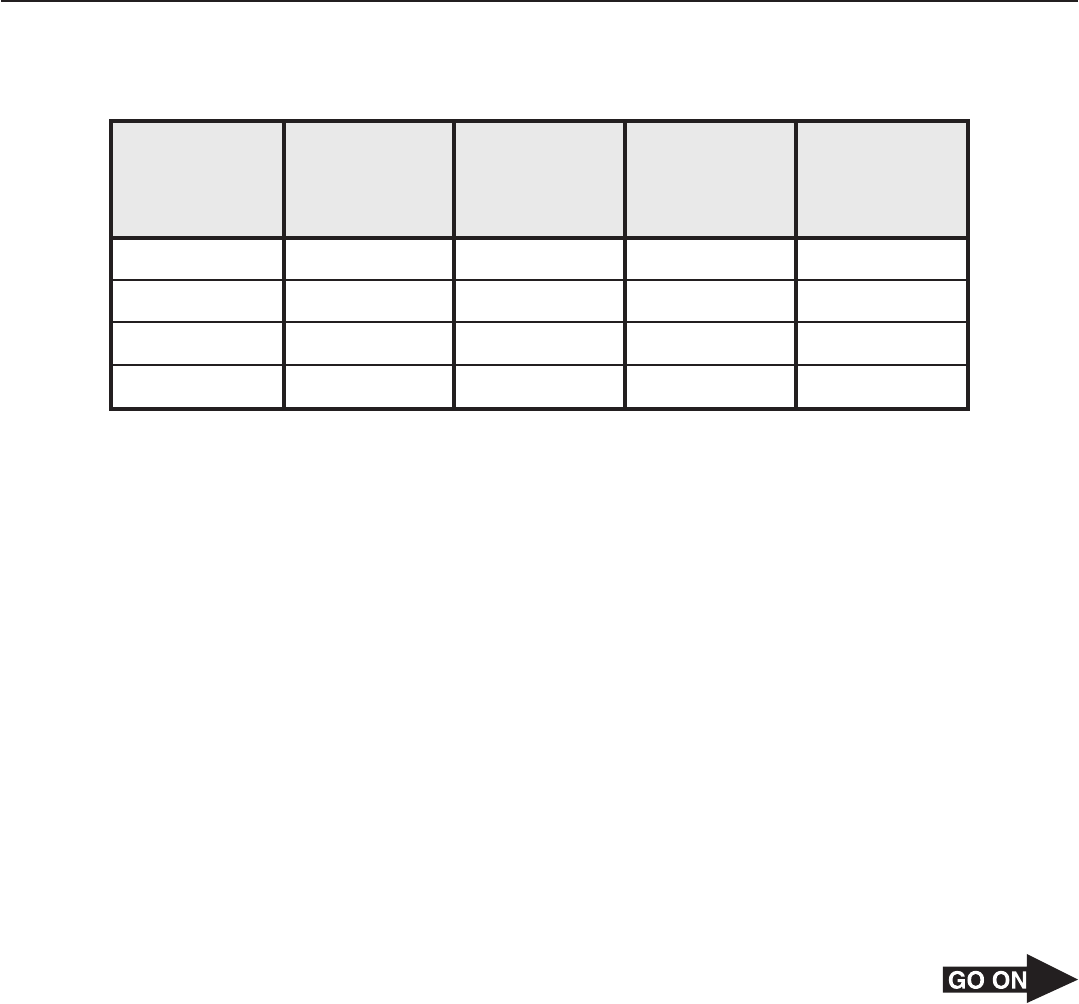
3 For a class demonstration a student turned off the lights in the classroom. The
student then shined light from a flashlight through a hole in a piece of cardboard. The
class saw the narrow beam of light continue until another student placed a mirror in
the light’s path.
The light did not continue past the mirror because —
A
light cannot travel very far
B the mirror absorbed all the light
C the light was refracted back to the light source
D light travels in a straight line and cannot go around objects
4 A table of different properties of four samples of matter is shown.
Sample
Conducts
Electricity
Conducts
Heat
Soluble in
Water
Physical
State at
Room
Temperature
1 No No Yes Solid
2 Yes Yes No Solid
3 No Yes Yes Liquid
4 Yes Yes No Liquid
Which conclusion can
be made about the samples based on the table?
F
Sample 1
is made of plastic.
G Sample 2 is made of metal.
H Sample 3 is attracted to magnets.
J Sample 4 is less dense than water.
Science
Page 5
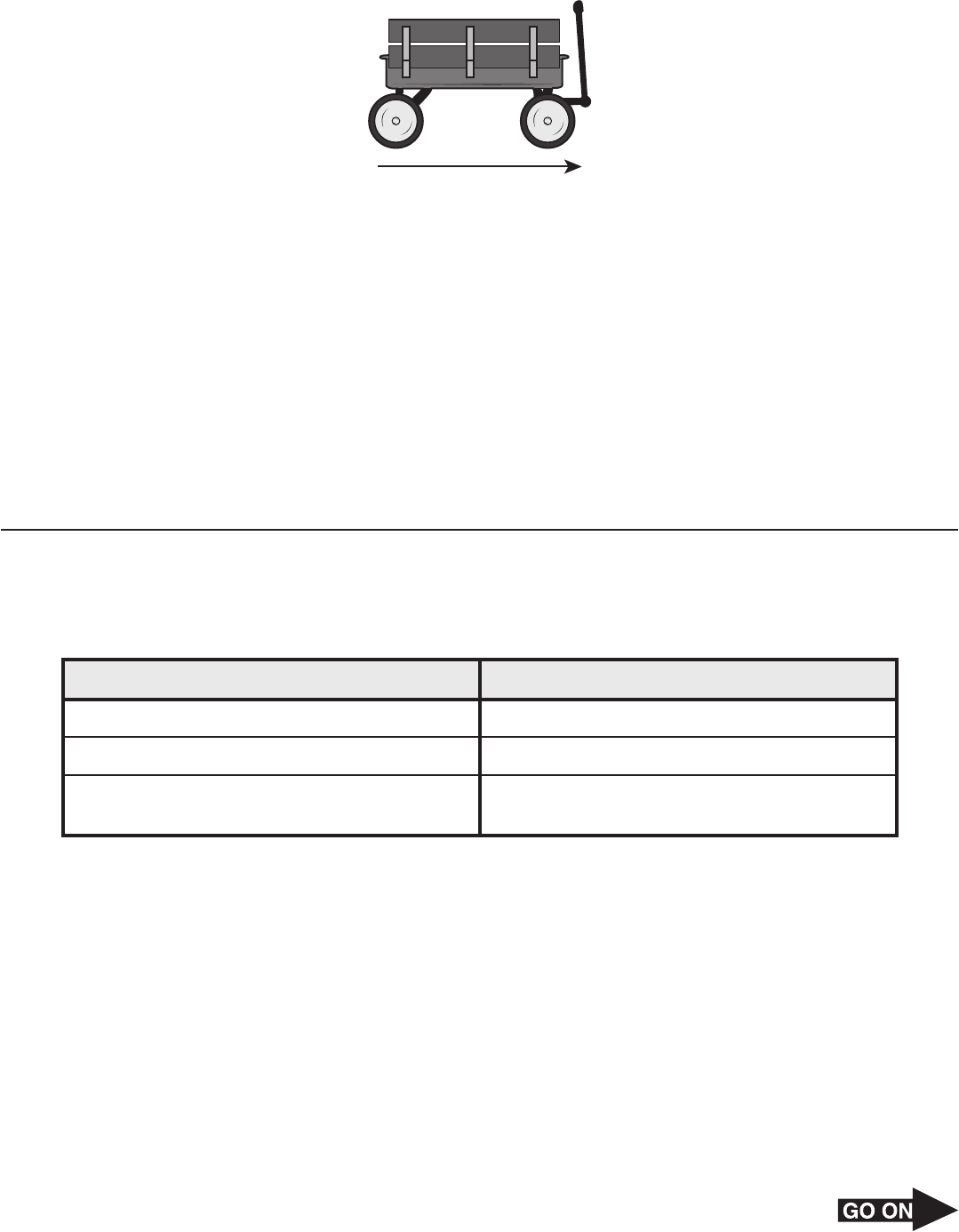
5 A wagon is pushed and begins to move. As the wagon moves, it slows and comes to
a stop. The wagon and the direction it is pushed are shown.
Direction wagon is pushed
What force causes the wagon to stop?
A
The force of gravity which is acting in the same direction as the arrow
B The force of friction which is acting in the same direction as the arrow
C The force of gravity which is acting in the opposite direction of the arrow
D The force of friction which is acting in the opposite direction of the arrow
6 Students made
a chart classifying animal behaviors.
Animal Behaviors
Inherited Learned
Bear looking for food in a trash can Dog coming when its name is called
Owl being active at night Pony pulling a cart
Turtle burying eggs
Squirrel getting seeds from a bird
feeder
Which animal behavior is NOT correctly classified?
F
Bear looking for food in a trash can
G Owl being active at night
H Dog coming when its name is called
J Squirrel getting seeds from a bird feeder
Science
Page 6

7 Canyons and mesas are two landforms found in the western part of the United
States. Which statement best describes how canyons and mesas are similar?
A
Both were formed by slow-moving glaciers.
B Both
were formed by erosion by wind and water.
C Both were part of a mountain that was weathered by ice.
D Both were part of a desert that was reshaped by a flood.
Science
Page 7
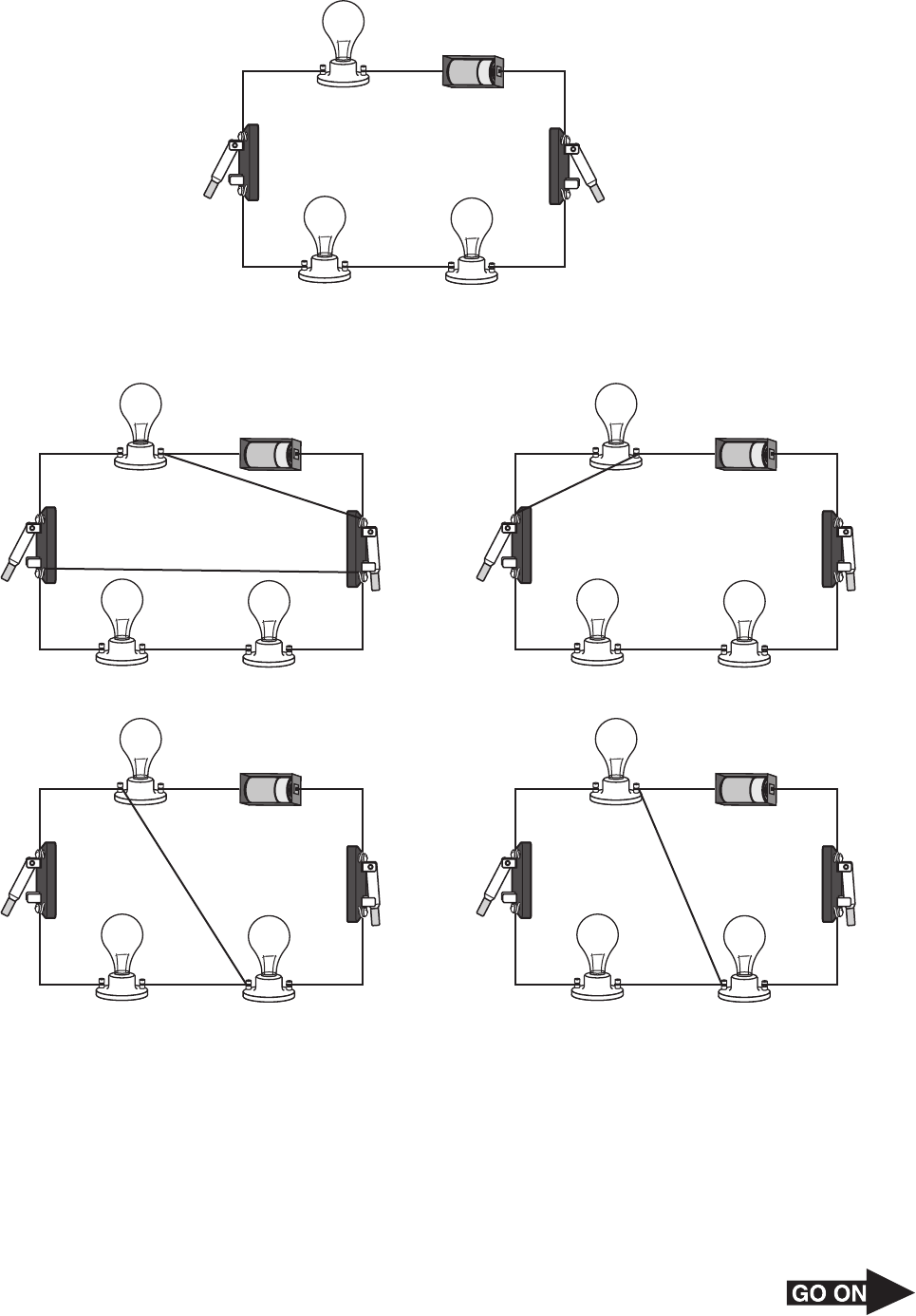
−
+
Switch 1 Switch 2
−
+
Switch 1 Switch 2
−
+
Switch 1 Switch 2
−
+
Switch 1 Switch 2
−
+
Switch 1 Switch 2
8 A student wants to make a change to the circuit shown below so that when Switch 1
is open and Switch 2 is closed, only one light will be on in the circuit.
Which diagram shows how the student should change the circuit?
F H
G J
Science
Page 8

9 Students researching the relationships between some organisms in the Lavaca Bay
ecosystem in Texas made this partial food web.
Bald eagles
Spotted sandpipers
Hermit crabs
Swamp sparrows
Swamp rabbits
Wiregrass
Blue crabs
Phytoplankton
Clover grass
Which of these lists contains only organisms that receive some of their energy
directly from other organisms that produce their own food?
A
Bald eagles and spotted sandpipers
B Swamp
rabbits, hermit crabs, and swamp sparrows
C Phytoplankton, hermit crabs, and blue crabs
D Wiregrass, clover grass, and phytoplankton
Science
Page 9
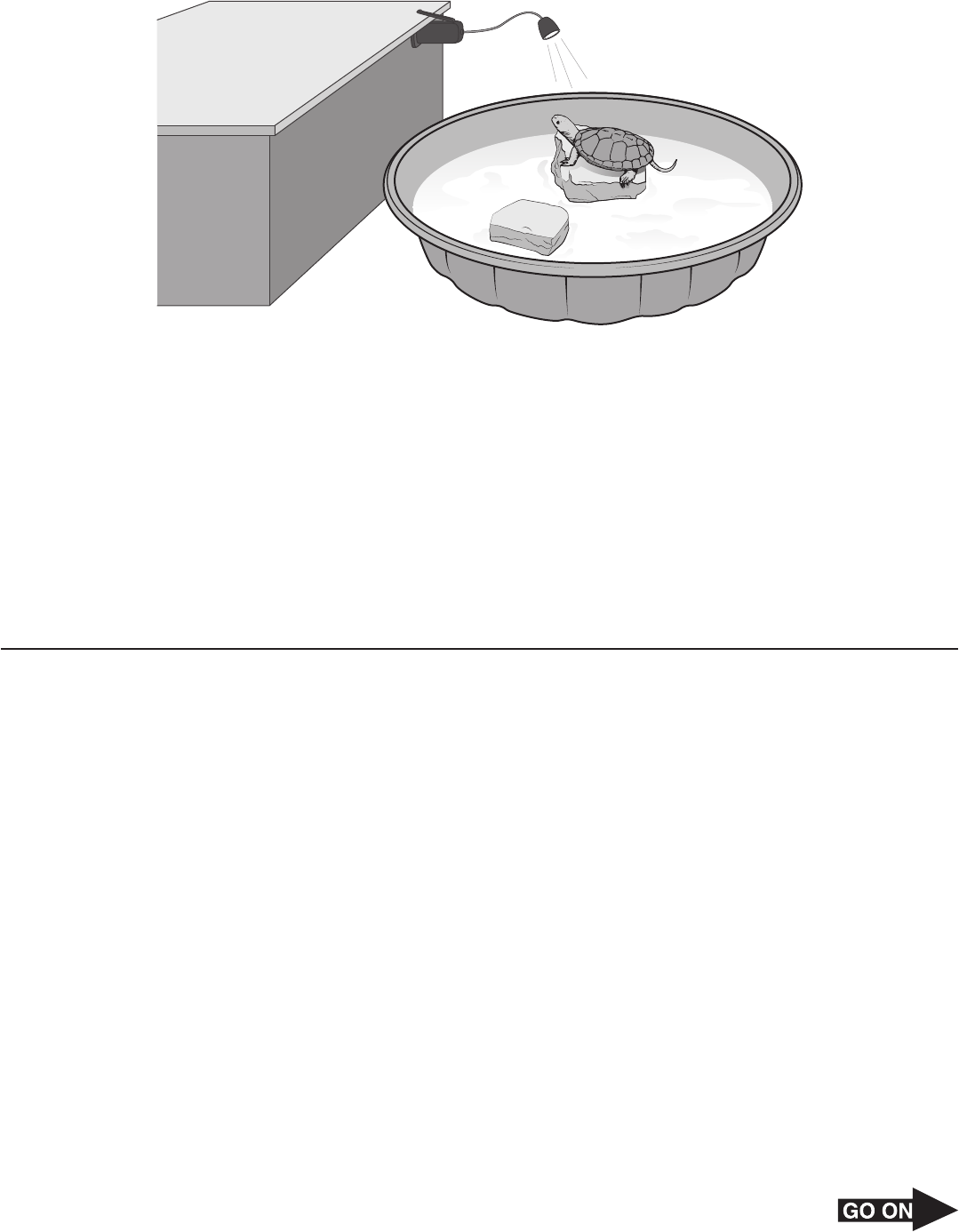
10 A science class is observing a pet turtle in a small plastic pool. The students turn on a
portable camping lamp that is clamped on to a counter next to the pool.
Which kind of energy is used by the portable lamp to produce light?
F Mechanical energy, because the lamp is clamped on to the counter
G Thermal energy, because the lamp increases the temperature of the water
H Electrical energy, because the lamp is battery-operated
J Sound energy, because the lamp vibrates when clicked on
11 Students observe a glass of ice and water. The glass is dry on the outside. After ten
minutes students see drops of water on the outside of the glass.
Which statement best explains the students’ observations?
A
The water vapor in the air changes to a liquid when it touches the cold glass.
B The cold water inside the glass rises and then slides down the outside of the glass.
C The ice in the glass melted and caused the water to overflow the glass.
D The water moved to the outside surface through tiny holes in the glass.
Science
Page 10
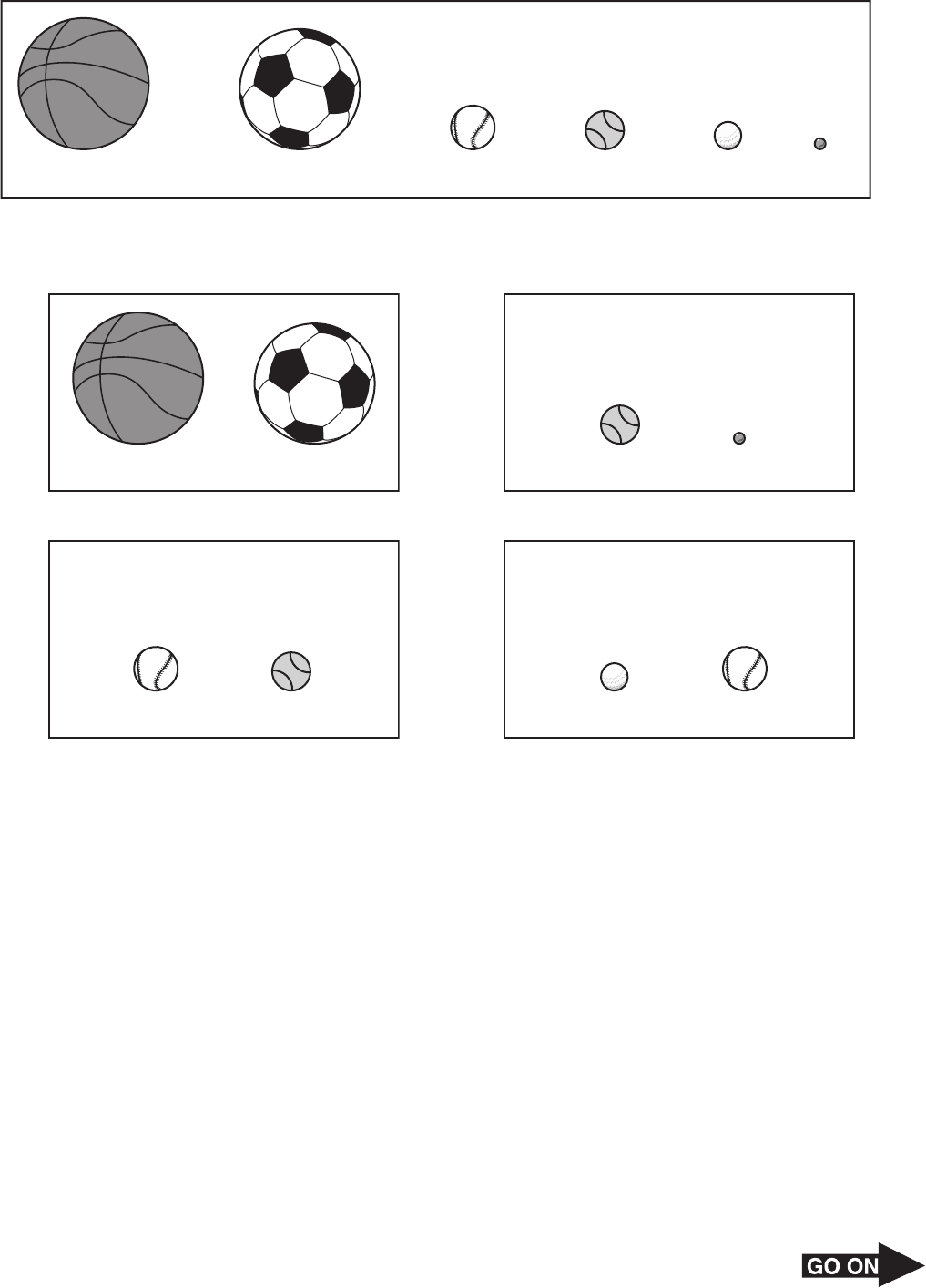
12 Students chose objects to model the relative sizes of Earth and the moon.
Basketball Soccer ball Baseball Tennis ball Golf ball Marble
Earth Moon
Which set of objects best compares the sizes of Earth and the moon?
F
Earth Moon
H
G
MoonEarth
J
MoonEarth
Science
Page 11
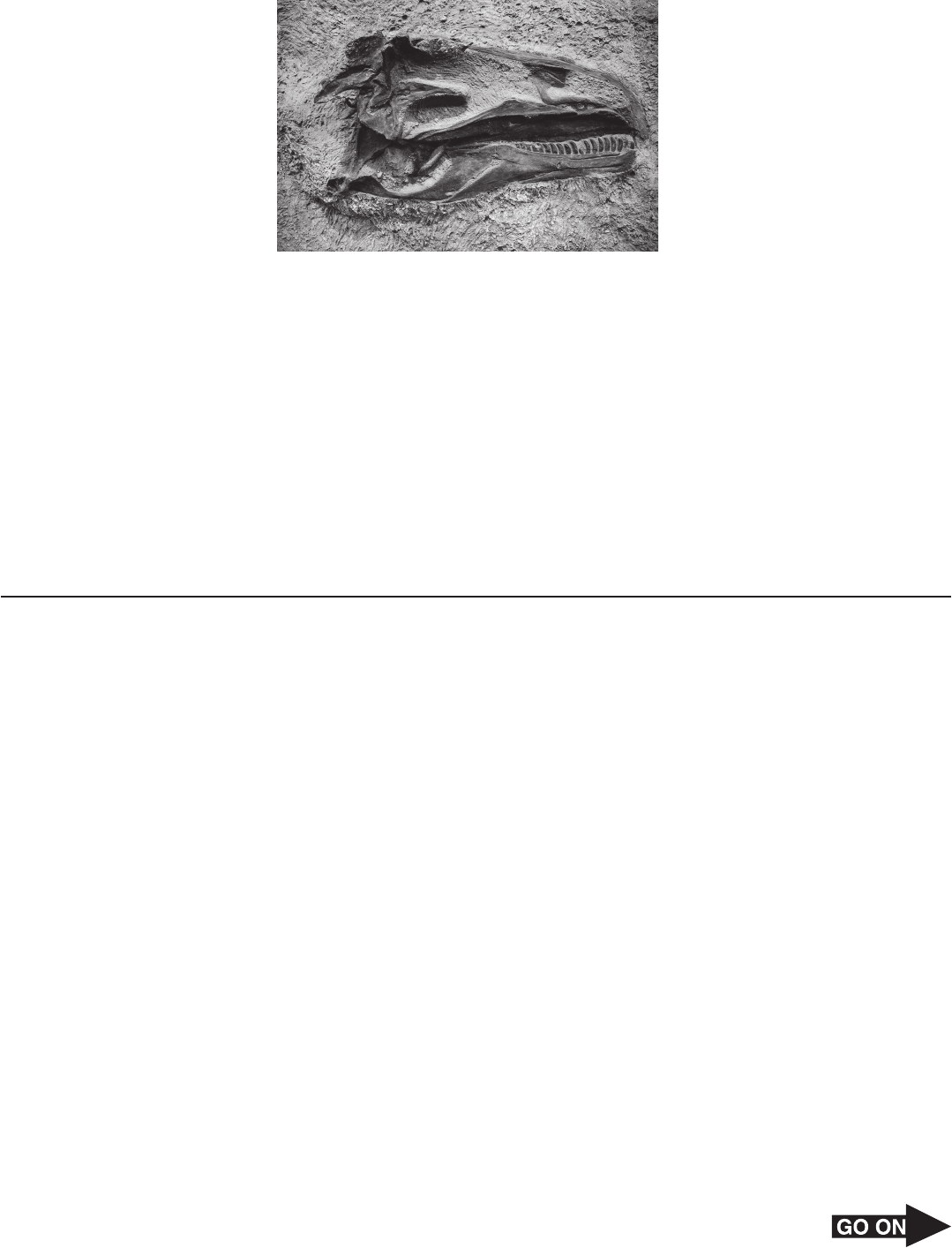
13 A dinosaur fossil is shown.
© iStock.com/zrfphoto
Which question can scientists most likely answer from studying the fossil of the
dinosaur?
A
What was
the pattern on the skin of the dinosaur?
B What was the type of food the dinosaur ate?
C How fast was the heart of the dinosaur beating?
D How many eggs were in the nest of the dinosaur?
14 In
the early 1600s, the astronomer Galileo used a telescope to make observations of
Mercury and Venus. What are the positions of these planets in relation to the sun?
F
Mercury is
the planet closest to the sun, and Venus is the second planet from the
sun.
G Mercury is
the second planet from the sun, and Venus is the third planet from the
sun.
H Venus is the planet closest to the sun, and Mercury is the second planet from the
sun.
J Mercury is the third planet from the sun, and Venus is the planet closest to the
sun.
Science
Page 12
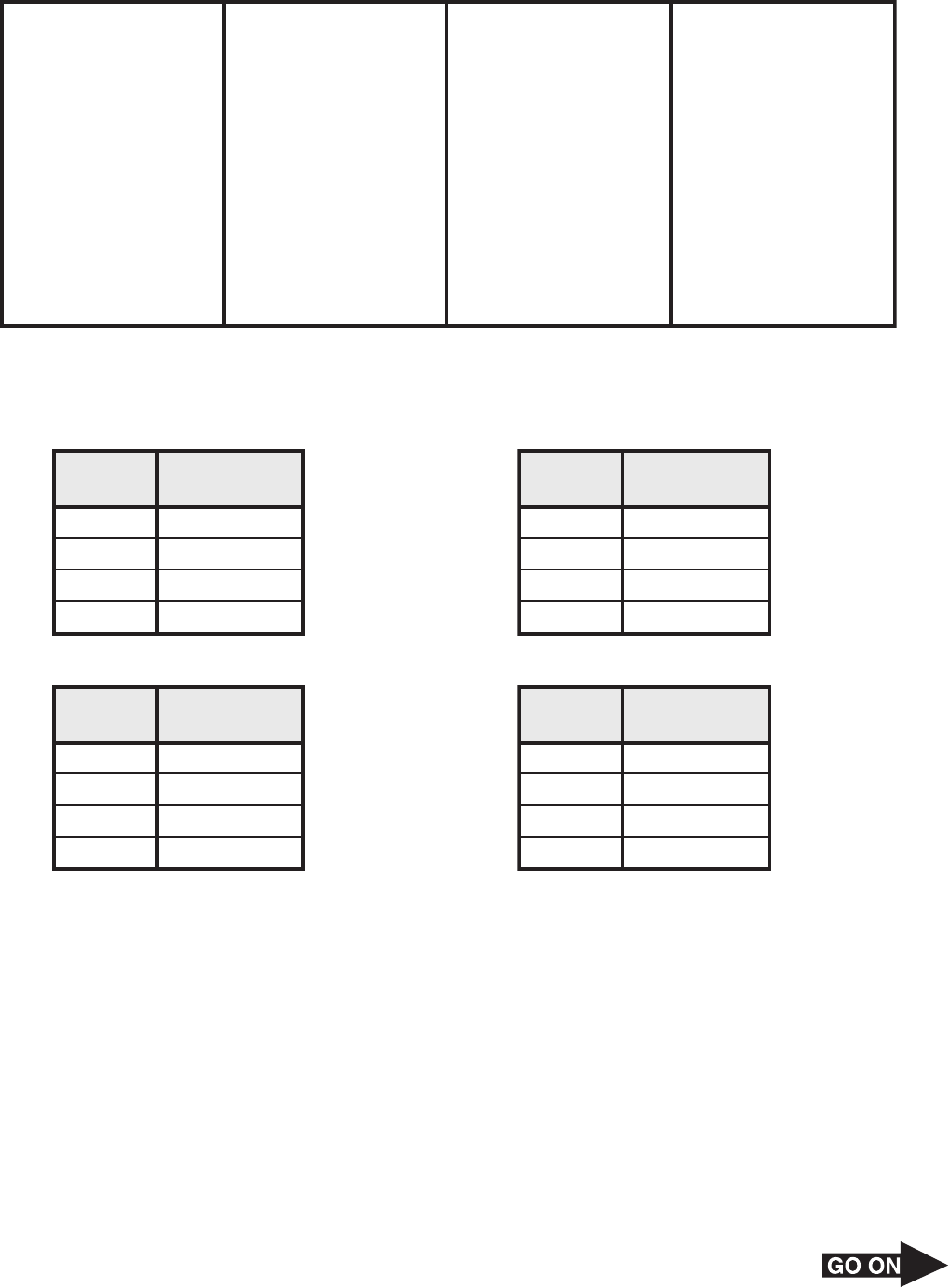
15 This chart describes some beak and toe adaptations that help four bird species
survive in different habitats.
Bird 1
Bird 2
Bird 3
Bird 4
• Long, sharp beak
for hammering
into tree trunks
• Sharp beak for
spearing fish
• Long toes for
walking on mud
and grasping
plants
• Heavy, pointed
beak with sharp
edges for splitting
open seeds
• Special toe
placement that
helps with
perching and
hopping
• Grooved beak for
straining food
from water
• Special toe
placement that
helps with
support on tree
trunk
• Webbed toes for
moving through
water
Based on these adaptations, which table best matches the bird species to its
environment?
A
Species
Type of
Environment
Bird 1
Prairie
Bird 2
Forest
Bird 3
Pond
Bird 4
Marsh
C
Species
Type of
Environment
Bird 1
Prairie
Bird 2
Marsh
Bird 3
Pond
Bird 4
Forest
B D
Species
Type of
Environment
Bird 1
Forest
Bird 2
Pond
Bird 3
Marsh
Bird 4
Prairie
Species
Type of
Environment
Bird 1
Forest
Bird 2
Marsh
Bird 3
Prairie
Bird 4
Pond
Science
Page 13
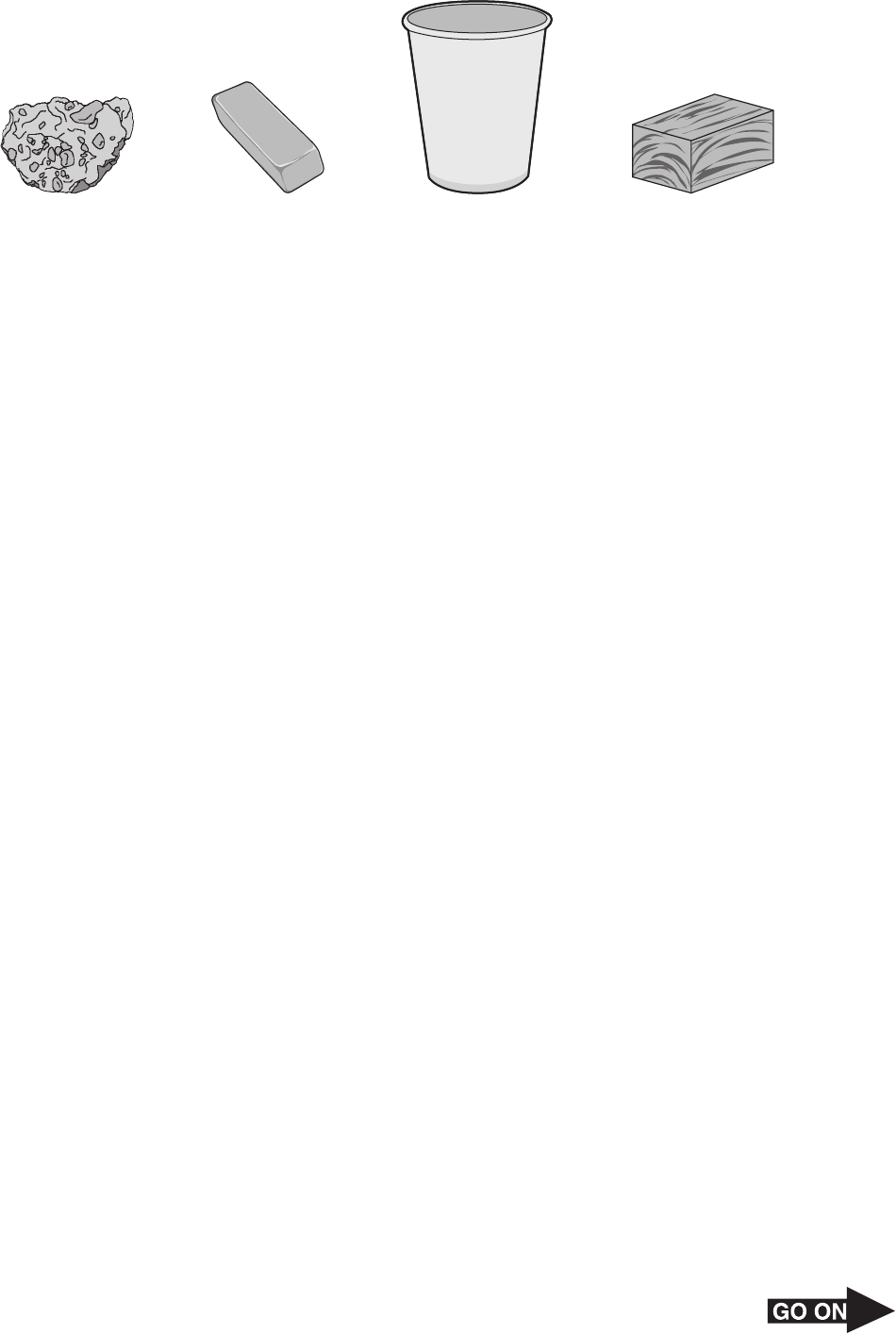
16 A student compares the physical properties of the four objects shown.
Rock Rubber eraser Paper cup Wooden block
Which of these physical properties do all four objects have in common?
F
They
all have the same physical state and conduct electricity.
G They all conduct electricity and attract the same metal objects.
H They all attract the same metal objects and are not soluble in water.
J They all are not soluble in water and have the same physical state.
Science
Page 14
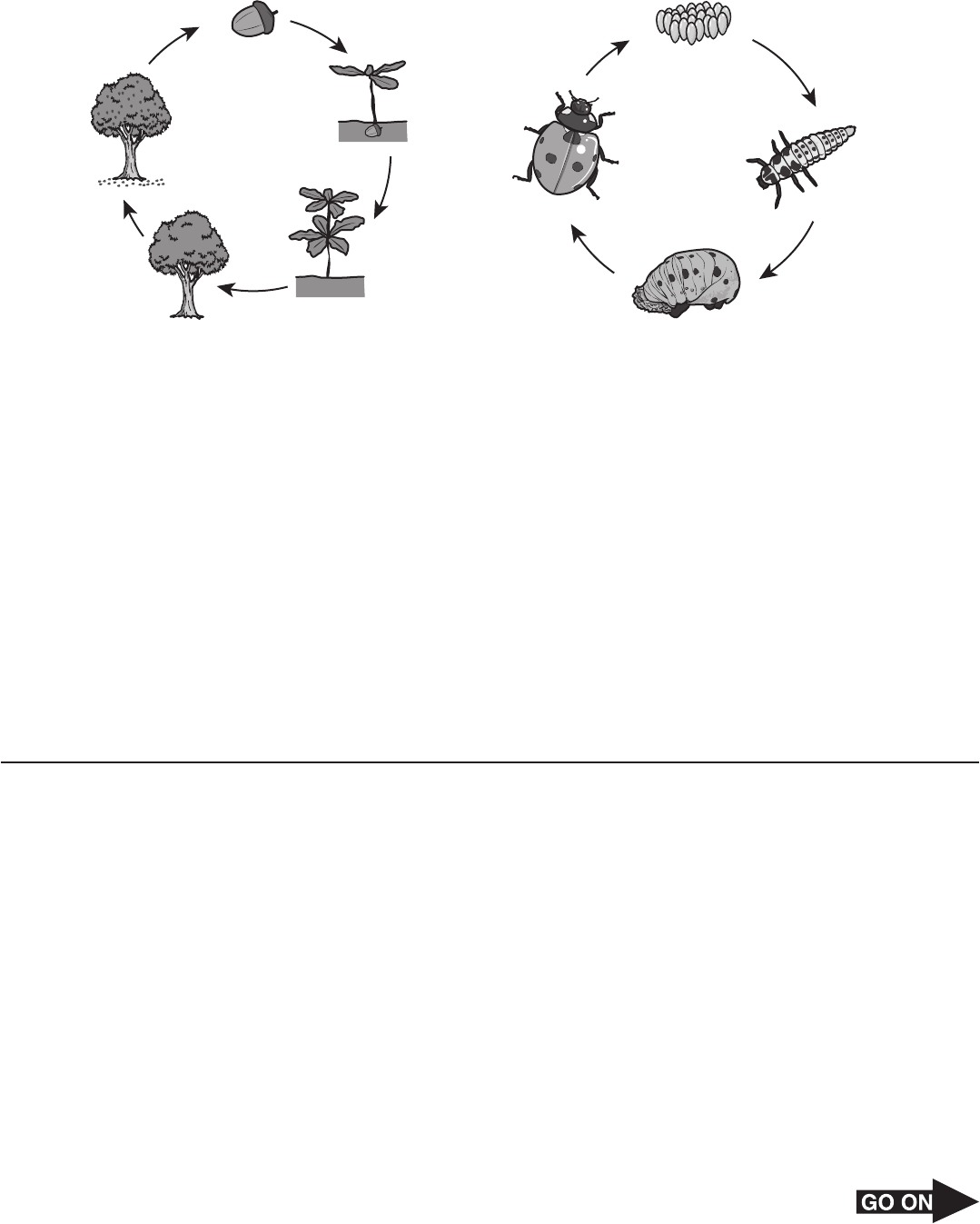
Oak Tree Life Cycle Lady Beetle Life Cycle
Eggs
Adult
Larva
Pupa
17 Students observe these diagrams showing the life cycles of an oak tree and a lady
beetle.
Which inference can be
made by comparing these diagrams?
A
Plants require
less energy than insects require to undergo changes from a young
organism to a mature organism.
B Insects and
plants follow a series of changes that allows them to survive and
reproduce.
C Insects are more likely than plants are to adapt to changes in the environment to
survive.
D Insects and plants are dependent on one another for survival.
18 Which process will happen when the sun interacts with the ocean?
F
Rain will
fall only on the land.
G Water will not evaporate at nighttime.
H Salt water will become fresh water vapor.
J Precipitation will happen less often.
Science
Page 15
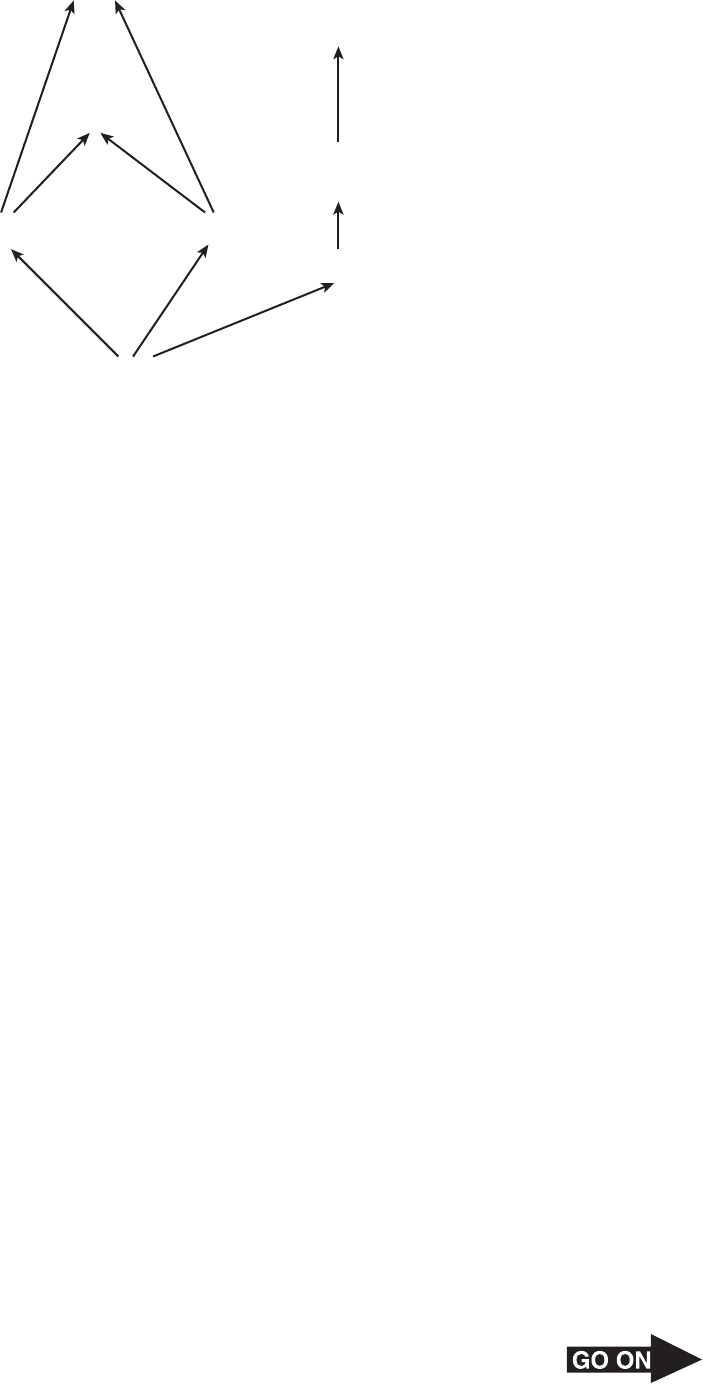
Cheetahs
Barn owls
Spotted
hyenas
Mountain zebras
Gemsboks
Grant’s
golden moles
Term ite s
Desert grasses and shrubs
19 A partial desert food web is shown.
Which food
chain shows one complete pathway in which energy flows through this
food web?
A
Desert grasses
and shrubs
→
barn owls termites
→
B Desert grasses and shrubs
→
cheetahsmountain zebras
→
C Desert grasses and shrubs
→
spotted hyenas termites
→
D Desert grasses and shrubs
→
Grant’s golden moles gemsboks
→
Science
Page 16
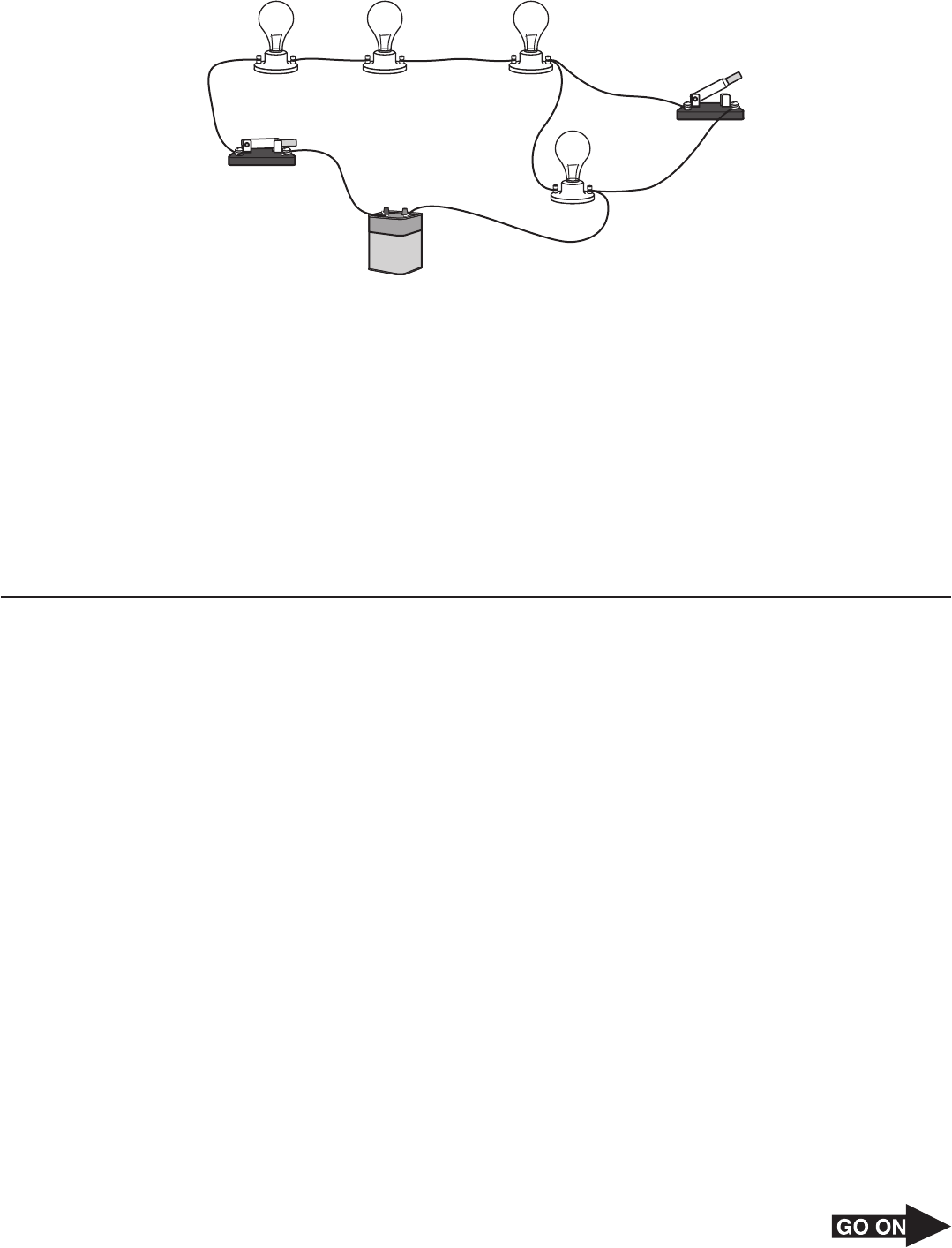
20 A student constructs the circuit shown for a science demonstration.
With the switches in these positions, which lights are on?
F
All the
lights
G Lights 1 and 2 only
H Lights 3 and 4 only
J None of the lights
21 A student
prepared a snack that consisted of grapes, pecans, and strawberries
sprinkled with white powdered sugar. The student stored the snack in a refrigerator.
An hour later the student observed that the powdered sugar could no longer be seen
but the fruit and nuts had not changed in appearance.
What most likely happened to the sugar in the mixture?
A
The sugar evaporated
at the lower temperature in the refrigerator without causing
any changes to the fruit and nuts.
B The sugar was
more dense than the other foods in the mixture, so it settled to the
bottom of the container.
C The sugar dissolved in the moisture on the fruit.
D The sugar absorbed energy from the nuts and melted into a colorless liquid.
Science
Page 17
1
4
3
2

22 The chart lists plants and animals interacting with parts of an environment.
1. A hummingbird dips its beak inside a flower.
2. A lizard burrows into the sand to stay cool.
3. A fish absorbs oxygen through its gills.
4. A cactus wren eats seeds from a cactus fruit.
5. A sea star clings to a rock in a tidal pool.
6. A bear scratches its back against a tree.
Which statements describe an animal interacting with a living part of the
environment?
F
Statements 1,
4, and 6 only
G Statements 1, 3, and 5 only
H Statements 2, 5, and 6 only
J Statements 2, 3, and 4 only
Science
Page 18
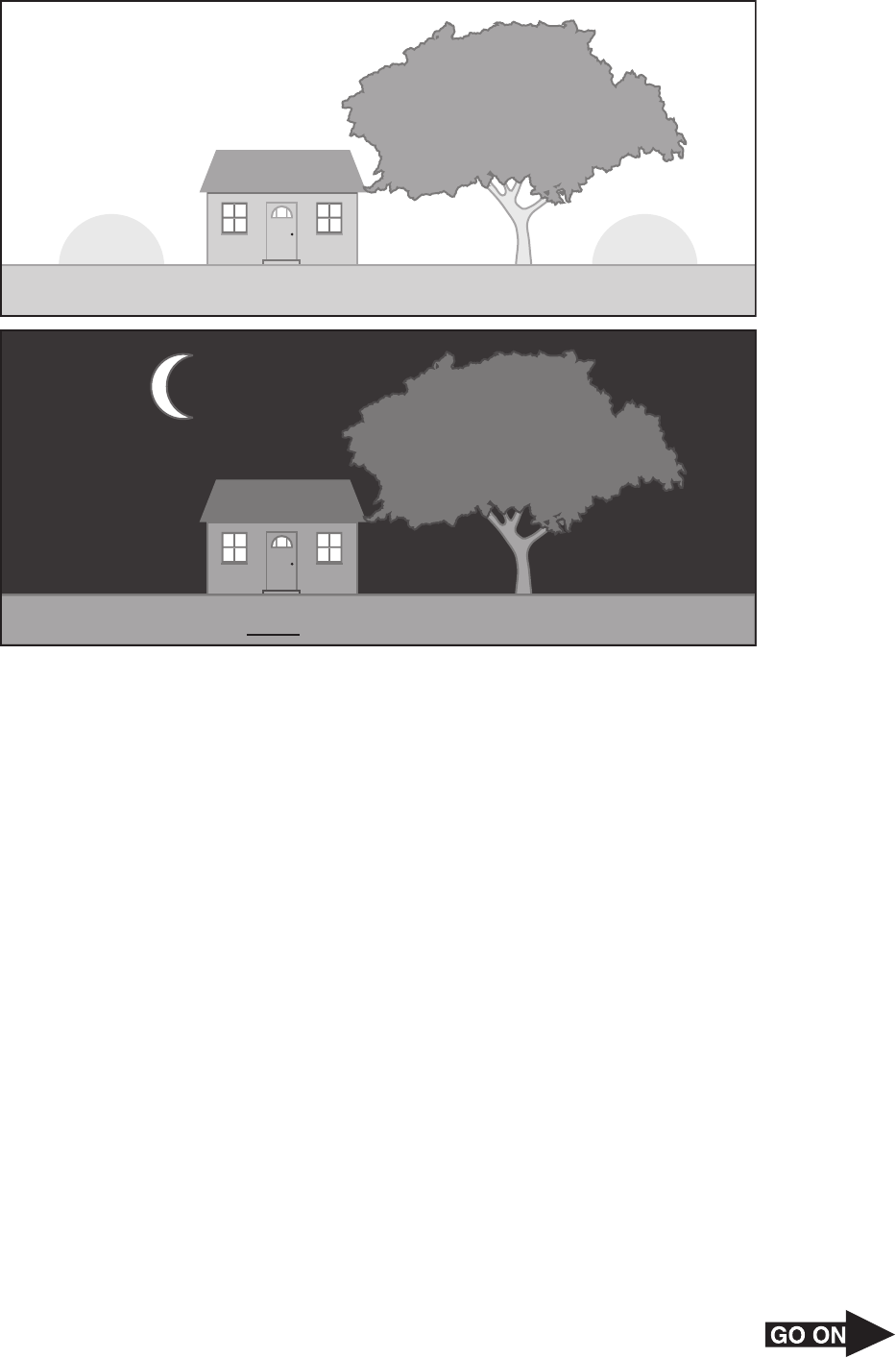
23 A student drew the following pictures to show the day-night cycle of Earth.
(sunrise 7:10 A.M.)
11 hours of daytime
Daytime
(sunset 6:10
P.M.)
Nighttime
? hours of nighttime
Based on the pictures, how many hours should the student record on the nighttime
picture to complete a day-night cycle?
A
11 hours
B 12 hours
C 13 hours
D 24 hours
Science
Page 19
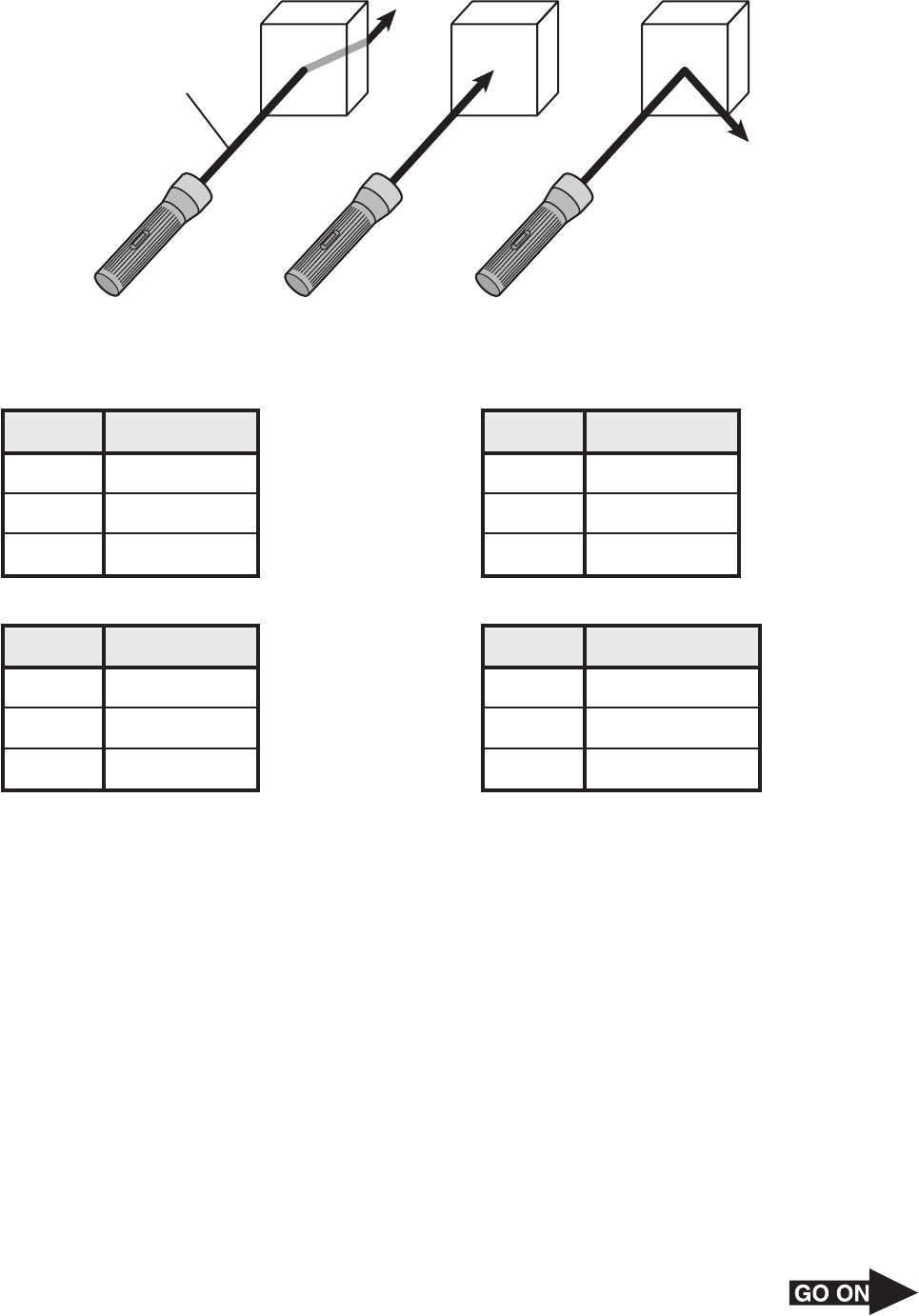
24 A student uses a flashlight to shine a beam of light on three different objects.
Object 1 Object 2 Object 3
Beam of light
Which table describes what happens to the light beam as it interacts with each
object?
F
Object Light Beam
1 Scattered
2 Absorbed
3 Reflected
H
Object Light Beam
1 Reflected
2 Absorbed
3 Refracted
G J
Object Light Beam
1 Refracted
2 Absorbed
3 Reflected
Object Light Beam
1 Absorbed
2 Refracted
3 Scattered
Science
Page 20
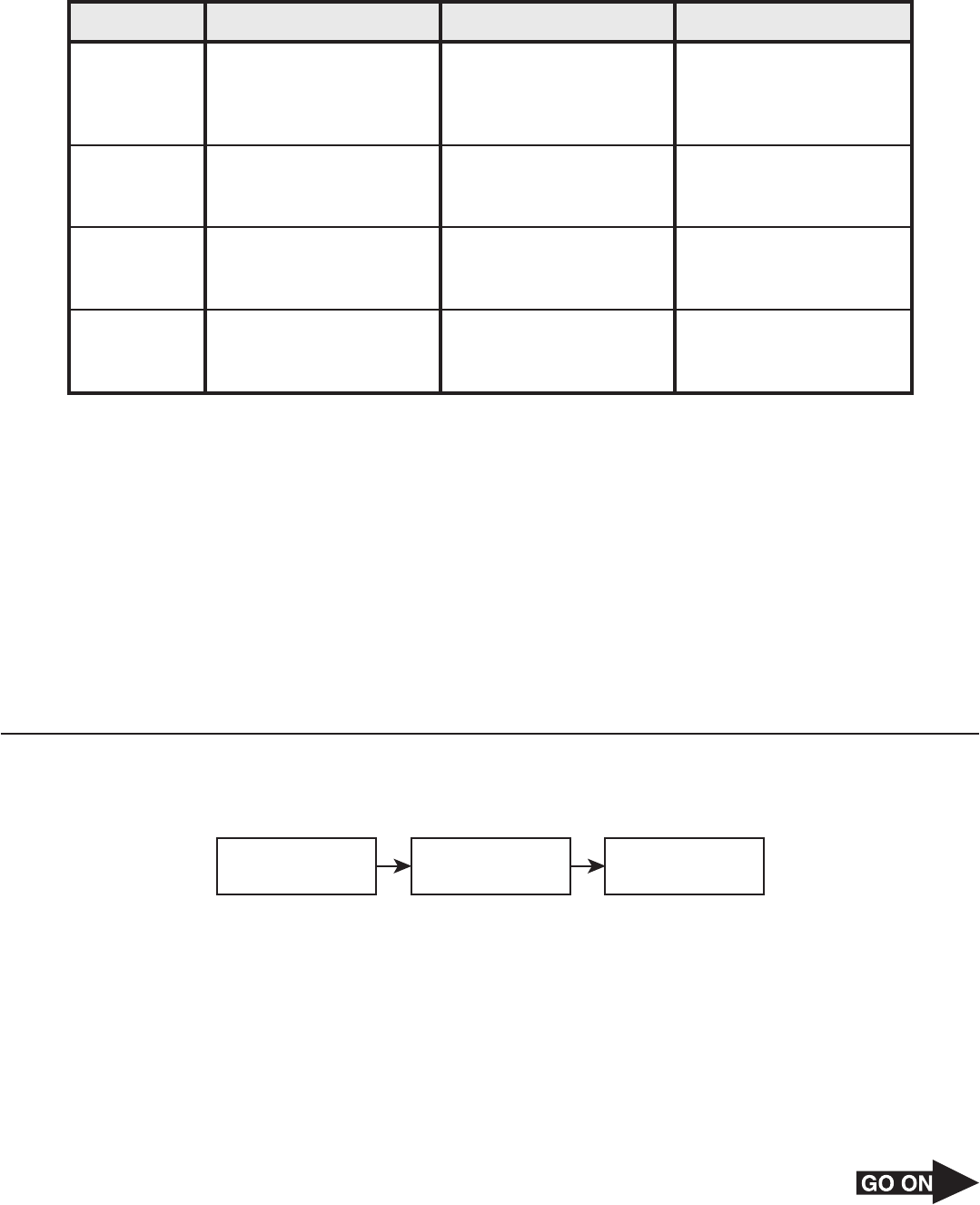
25 White oak trees grow to be 24 to 30 meters tall. Their long branches are covered
with leaves, and their roots reach deep into the soil to hold the tree in place. White
oaks drop their leaves during the winter months.
Characteristics of Four Ecosystems
Ecosystem Temperature Yearly Precipitation Soil
1
Long, cold winters
with temperatures
below 0 °C and
short, cool summers
Less than 25 cm of
rain
Thin layer of topsoil;
frozen ground below
2
Warm throughout
the year, very hot in
summer
Less than 28 cm of
rain
Sandy, rocky soil
3
Cold-to-moderate
winters and warm
summers
Between 76 and
152 cm of rain
Rich, deep soil
4
Warm and wet
year-round
Between 200 and
1000 cm of rain
Soil drains quickly;
thin top layer of
humus
In which ecosystem would forests of white oak trees be most likely to survive?
A
Ecosystem 1
B Ecosystem 2
C Ecosystem 3
D Ecosystem 4
26 A three-step process is shown.
CementationCompactionDeposition
Which of these are most likely formed by the process shown?
F
Glaciers
G Mountains
H Sand dunes
J Sedimentary rocks
Science
Page 21

27 A group of students is given four small cubes of the same size and instructed to place
them in a beaker of water. One cube floats to the surface of the water. Two of the
cubes float in the middle of the beaker under the surface of the water. The last cube
sinks to the bottom of the beaker.
Which conclusion is best supported by what the students observed?
A
Two of the four cubes are soluble in water.
B All four cubes have different masses.
C Each cube is made of a different type of solid material.
D One of the cubes is more dense than the other three.
28 Which effect would most likely occur if a six-lane highway were built through an
ecosystem?
F
Competition for
resources would be reduced.
G Habitats available to animals would be reduced.
H Air pollution would decrease.
J Water pollution would decrease.
Science
Page 22
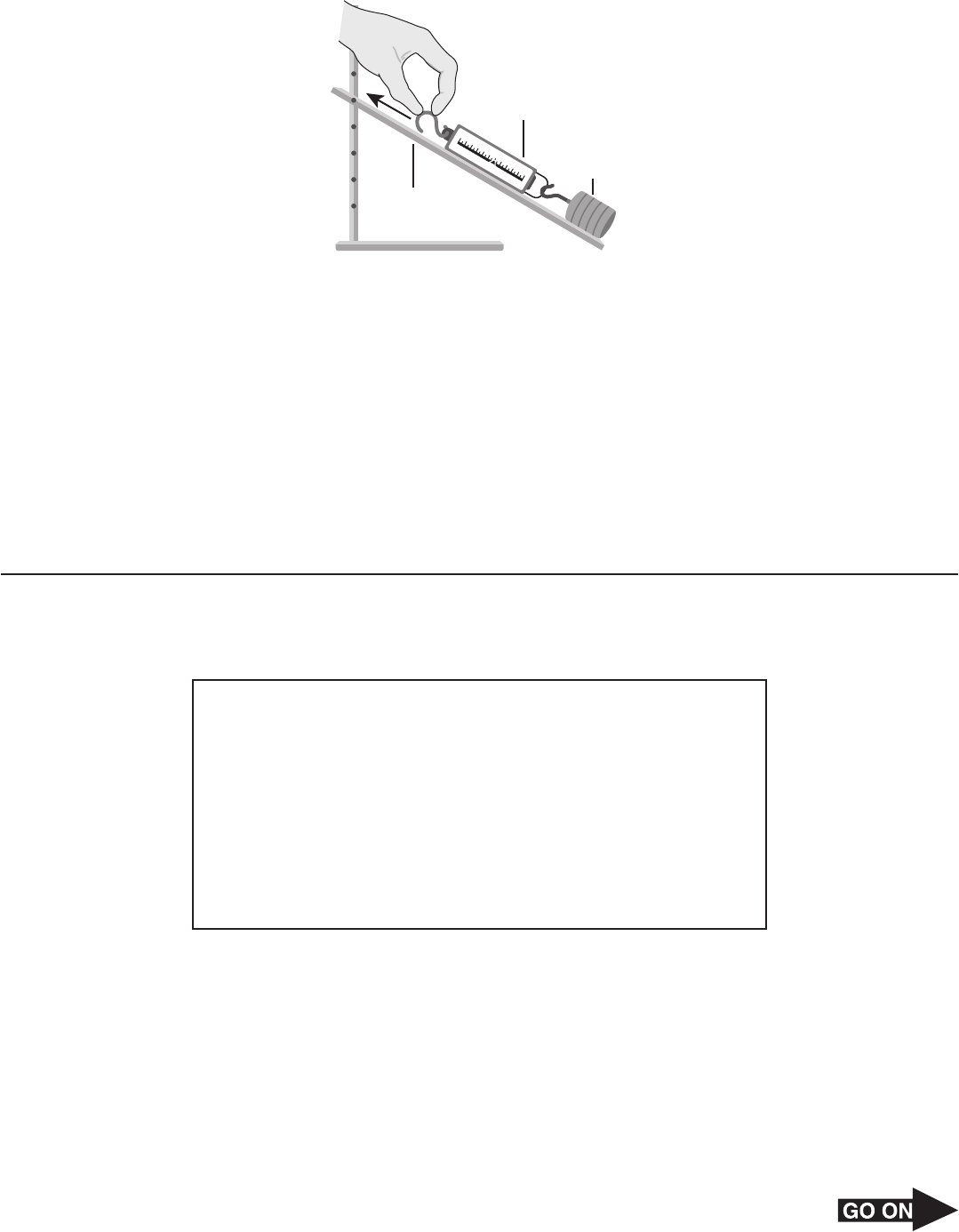
29 Students investigate force. The masses they use begin at rest on the ramp. The
setup the students use is shown.
Masses
Spring scale
Ramp
Which change will reduce the amount of force needed to move the masses?
A
Decrease the height of the ramp
B Increase the height of the ramp
C Add an additional mass
D Pull the spring scale with two hands
30
Students record characteristics of a tomato plant. One student’s list is shown.
Tomato Plant Characteristics
• Stems with branches that have many wide leaves
• Roots growing out of lower stem into the ground
• Small yellow flowers
• Seven large red tomatoes
• Four small green tomatoes
Which tomato plant characteristic is least likely to be inherited?
F
Flower color
G Leaf shape
H Type of roots
J Number of tomatoes
Science
Page 23
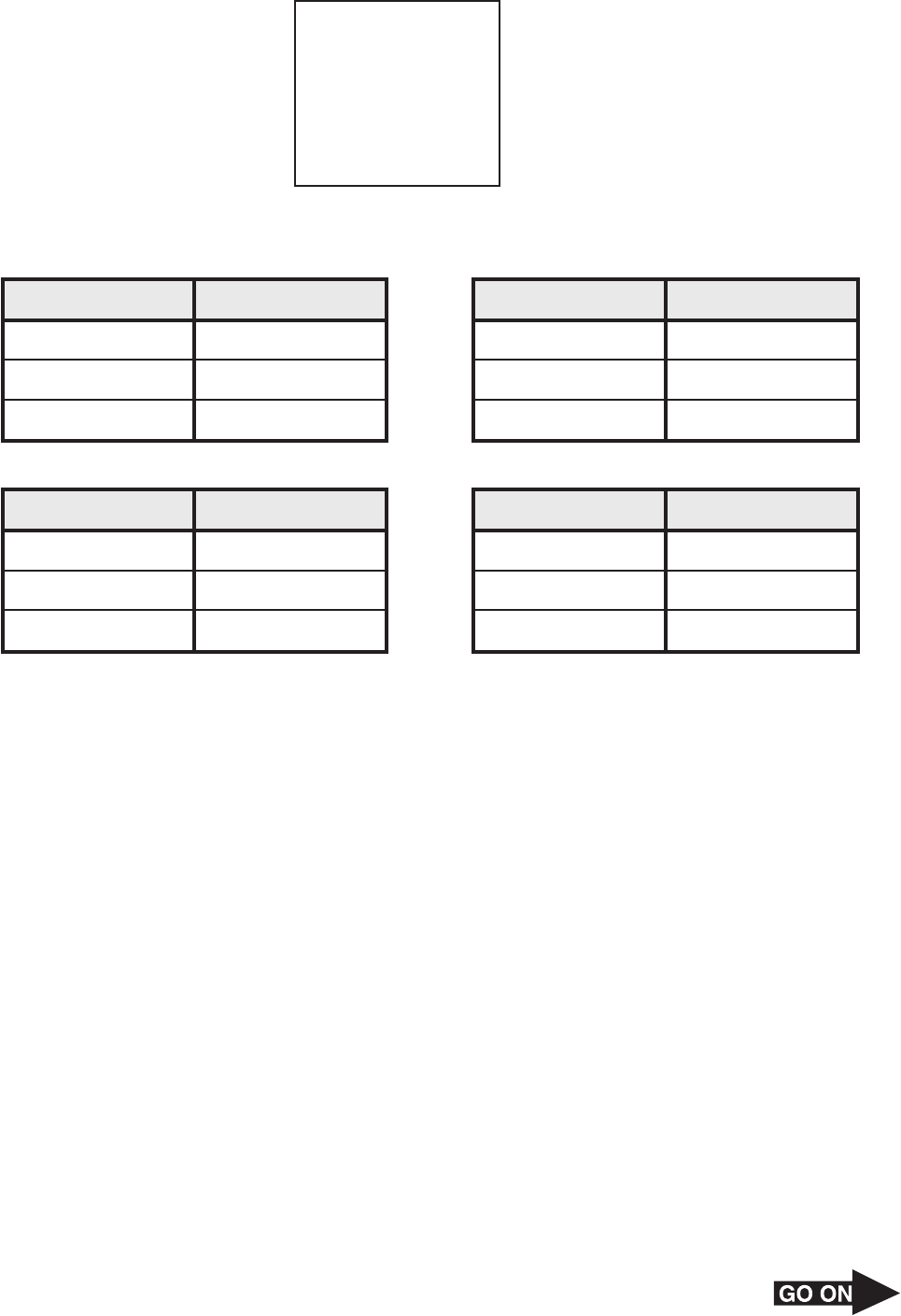
31 Students list resources that are used to heat buildings.
• Wood
• Coal
• Natural gas
• Petroleum
• Solar energy
Which of these tables correctly classifies the resources?
C
A
Renewable Nonrenewable
Solar energy Petroleum
Wood Natural gas
Coal
Renewable Nonrenewable
Wood Solar energy
Coal Petroleum
Natural gas
B D
Renewable Nonrenewable
Solar energy Coal
Natural gas Petroleum
Wood
Renewable Nonrenewable
Petroleum Solar energy
Natural gas Wood
Coal
Science
Page 24

32 A student mixes a sample of stones with a sample of table salt. The mass and volume
of the samples were determined before mixing the samples. The mass and volume of
each sample is shown.
Material
Grams
(g)
Milliliters
(mL)
Stones 45 25
Salt 40 35
Which statement is true about the mixture?
F
The mass of the mixture is 85 grams.
G The mass of the mixture is 60 milliliters.
H The volume of the mixture is 60 grams.
J The volume of the mixture is 85 milliliters.
Science
Page 25
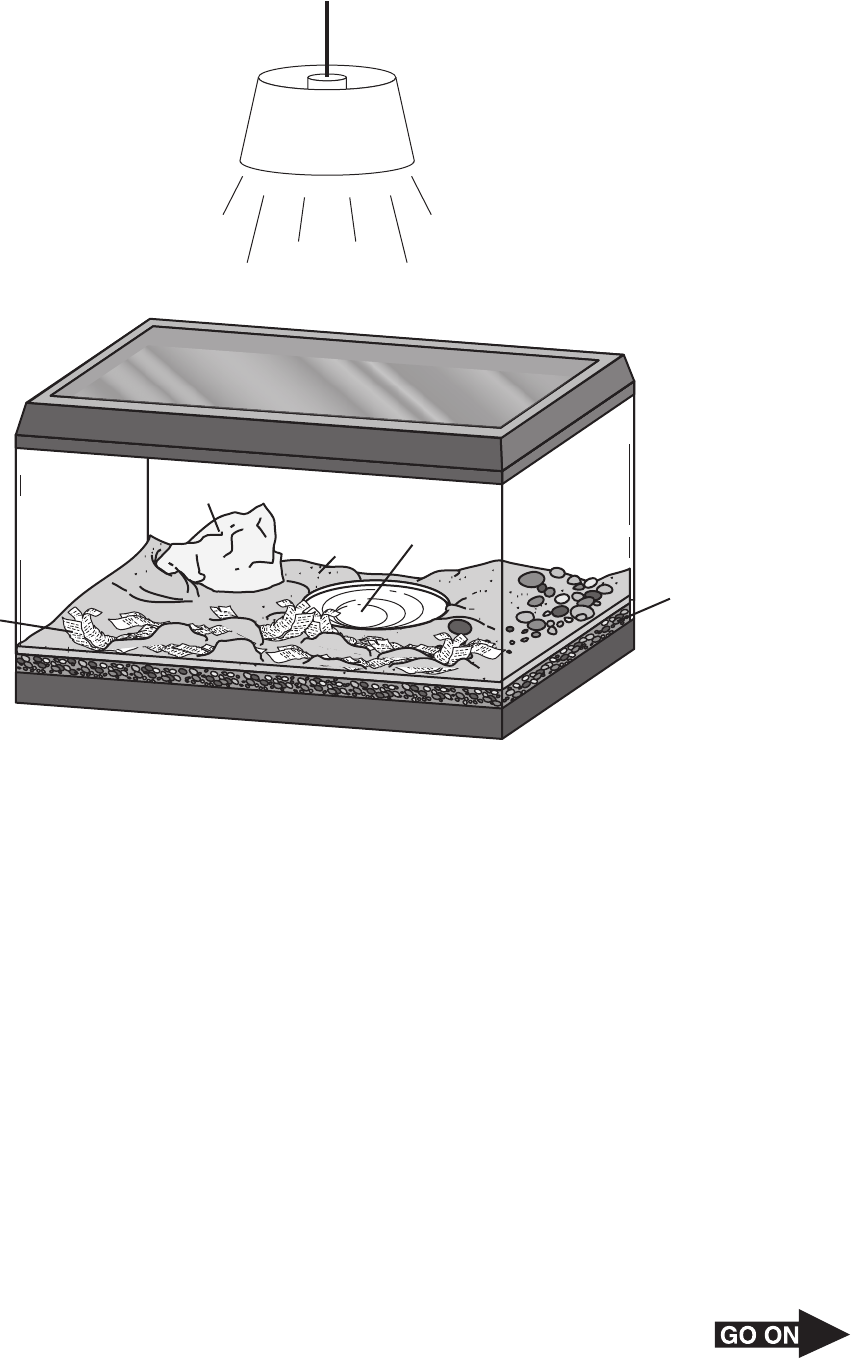
W
Rock
Sand
Water
Shredded
aterWater
Gravel
newspaper
for food
33 A student’s model of a closed ecosystem is shown. The student plans to add land
snails to the model in order to show how the snails interact with different parts of the
ecosystem.
What should the student add to the model so that the snails will survive?
A
Fish to provide food
B Sticks to provide a place to hide
C Deep water to provide carbon dioxide
D Living plants to provide oxygen
Science
Page 26
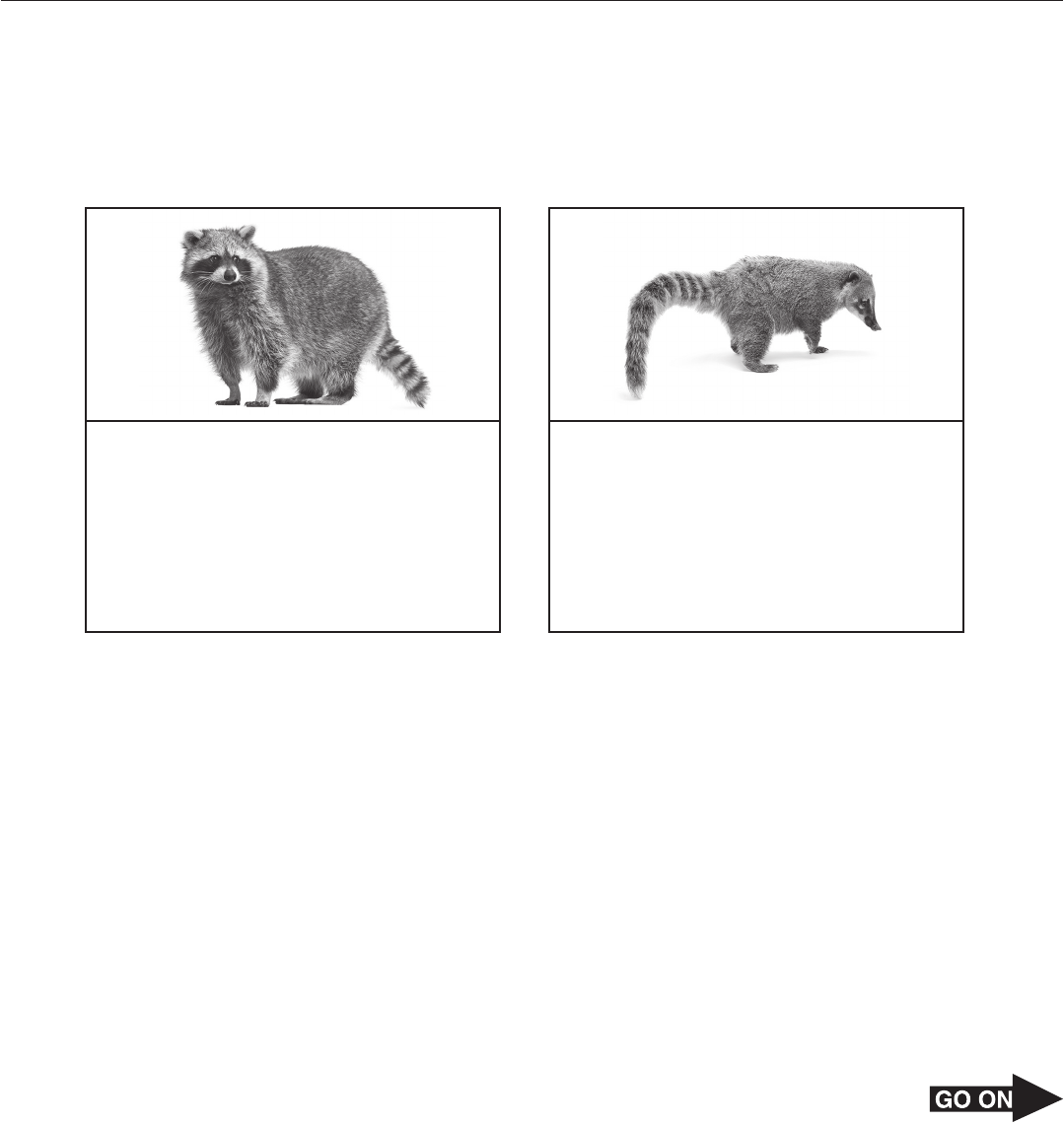
34 Deltas are large landforms found along coastlines. What process forms deltas?
F
Cementation of sediments by rivers
G Deposition of sediments by rivers
H Erosion of sediments by ocean waves
J Deposition of sediments by ocean waves
35
The raccoon can be found in most areas of Texas. The coati has a smaller territory
and is found from Big Bend to Brownsville. These two species are related. The chart
shows the characteristics of these two species.
Raccoon Coati
© iStock.com/GlobalP
© iStock.com/Oktay Ortakcioglu
• Sharp teeth and powerful claws
• Paws with flexible toes
• Good eyesight at night
• Eats fruits, berries, insects,
rodents, frogs, fish, eggs, corn
• Long fluffy tail
• Sharp teeth and long claws
• Paws with flexible toes
• Good eyesight at night
• Eats insects, lizards, frogs, roots,
fruits, nuts, and eggs
• Long tail that helps in balancing
Which statement does NOT describe how the body structures of these animals help
them escape predators?
A
Paws with long claws on flexible toes help them climb trees.
B Sharp teeth allow them to catch prey on land or in water.
C Long tails allow them to balance on branches in trees.
D Good eyesight helps them to see at night.
Science
Page 27

36 Sediments are transported at different speeds. Which type of sediment transport is
the slowest?
F
Transport by rivers
G Transport
by winds
H Transport
by glaciers
J Transport
by ocean currents
BE SURE YOU HAVE RECORDED ALL OF YOUR ANSWERS
Science
Page 28
ON THE ANSWER DOCUMENT.
STOP

STAAR
GRADE 5
Science
May 2021
